Related Research Articles

The Zlin Trener is a family of aircraft that was based on a basic training aircraft, the Z-26.

The PZL-105 Flaming (flamingo) is a Polish short-takeoff-and-landing (STOL) utility aircraft designed by PZL "Warszawa-Okęcie". It remained a prototype.

The MBB Bo 209 Monsun is a two-seat light aircraft that was developed in West Germany in the late 1960s.
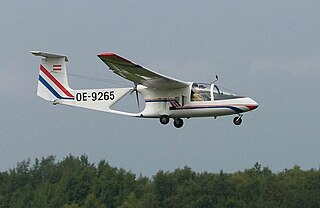
The Brditschka HB-3, HB-21 and HB-23 are a family of motor gliders of unorthodox configuration developed in Austria in the early 1970s.

The Bréguet 280T was a French biplane airliner of the late 1920s, created by the manufacturer as a means of finding a civil market for their 19 warplane, as they had once tried before with the 26T.
The Brochet MB.120 was a two-seat light aircraft developed in France in the 1950s.

The Brügger MB-1, MB-2 and MB-3 Colibri is a family of small sports aircraft designed in Switzerland in the 1960s and 1970s for amateur construction.
The Civil Aviation Department Revathi was a light utility aircraft designed in India principally for use by that country's flying clubs.
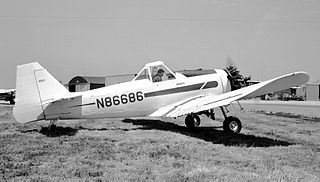
The Weatherly Model 201 is a 1960s American agricultural monoplane designed and built by the Weatherly Aviation Company of Hollister, California.
The ICA IS-28 is a two-seat sailplane produced in Romania in the 1970s. An all-metal aircraft of conventional design with a T-tail, it was originally produced with 15-metre wings, but in 1973, production shifted to the IS-28B with 17-metre wings and numerous aerodynamic refinements. These included a smaller tail with decreased dihedral, decreased dihedral on the wings, and redesigned fuselage contours. This version first flew on 26 April 1973 and was subsequently produced in versions with flaps (IS-28B2) and without (IS-28B1). Around 100 had been built by the early 1980s, with a substantial number sold for export. On April 7, 1979, Tom Knauff and R. Tawse set a world record with the IS-28 B2 glider, covering a distance of 829 kilometres on a predetermined out-and-return course from the Ridge Soaring Gliderport in Julian, Pennsylvania.
The ICA IS-32 is an open class high-performance metal two-seat sailplane produced in Romania in the 1970s. A refinement of the IS-28B, it shared most of that aircraft's fuselage, mated to new wings and empennage. This new wing had a span of 20 metres, featuring interconnected ailerons and flaps, Schempp-Hirth-type airbrakes. It had no provision for water ballast. The monowheel undercarriage differed from the IS-28 in being fully retractable.

The Piel CP.70 Beryl is a French twin-seat, single-engine sport aircraft designed by Claude Piel. It was first flown in France in the 1960s and marketed for amateur construction.
The Pottier P.50 Bouvreuil ("Bullfinch") was a single-seat, single-engine racing aircraft developed in France in the late 1970s and marketed for homebuilding. It was a low-wing cantilever monoplane of conventional design with an enclosed cockpit. The undercarriage was of tailwheel configuration, and the P.50 was designed from the outset to offer the builder the alternative of fixed or retractable main units. Construction throughout was of wood, except for the engine cowling and main wheel spats, which were fibreglass mouldings.
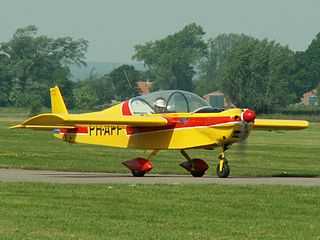
The Pottier P.70 was a single-seat, single-engine sport aircraft developed in France in the 1970s and marketed for homebuilding. It was a mid-wing cantilever monoplane of conventional design with an enclosed cockpit. Originally designed with fixed, tricycle undercarriage, the plans were later revised to offer a fixed, tailwheel option. Construction throughout was of metal. A two-seat, tandem version was developed as the P.170.
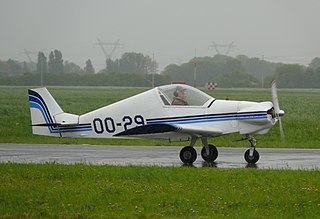
The Pottier P.80 is a single-seat, single-engine sport aircraft developed in France in the late 1970s and marketed for homebuilding. Ultimately based on the P.70 design, it features a redesigned wing and cockpit canopy. The P.80 is a low-wing cantilever monoplane of conventional design with an enclosed cockpit. Construction throughout is of metal. The prototype was constructed and unveiled at the 1977 Paris Air Show.

The Rand Robinson KR-1 is a single-seat, single-engine sport aircraft designed in the United States in the early 1970s and marketed for homebuilding. A two-seat version is marketed as the KR-2. It is a low-wing cantilever monoplane of conventional design with an enclosed cockpit and tailwheel undercarriage. As originally designed, the main undercarriage units of the KR-1 and basic KR-2 were manually retractable, folding backwards into the wings, while the KR-2T tandem-seat version had fixed tricycle undercarriage. However, some builders choose fixed tailwheel or even fixed tricycle undercarriage for KR-1s and KR-2s.

The Jurca MJ-2 Tempete is a single-seat sport aircraft designed in France in the mid 1950s and marketed for homebuilding.
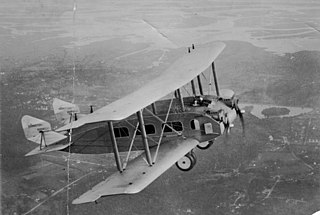
The Burnelli RB-1 was a US twin engine biplane airliner prototype from 1920, incorporating a lifting body fuselage.

The Jodel DR1050 Excellence and Ambassadeur are part of a family of French built aircraft, designed by Jean Délémontez in collaboration with Pierre Robin, as a development of the Jodel D.10 project. The aircraft was built from 1958 to 1967 both by Centre-Est Aeronautique (CEA) and by Société Aéronautique Normande (SAN) but since the demise of the latter in 1968 has only been supplied as plans.
The Kaminskas Jungster I aka Papoose RK-1 Jungmeister I is a single-seat homebuilt biplane.
References
| Wikimedia Commons has media related to Pottier P.130 . |
- Jane's All the World's Aircraft 1987–88 . London: Jane's Publishing.
- Taylor, Michael J. H. (1989). Jane's Encyclopedia of Aviation. London: Studio Editions.
| This article on an aircraft of the 1980s is a stub. You can help Wikipedia by expanding it. |